Erstellt am: 14. 5. 2016 - 10:00 Uhr
A Festering Wound
FM4 Reality Check
Hear the programme in the FM4 Player or subscribe to the podcast and get the whole programme after the show
The question that we’re asking on this Saturday’s Reality Check special is whether a war ends when the final bullet is fired? And what are the dangers of letting a wound fester?
The war on most of our minds right now is the brutal conflict in Syria, but this month marks just 7 years since the end of another ferocious civil war in Sri Lanka - notably for its cycles of brutality and the high toll paid, on both sides, by the civilian population.
"The government has changed, the war is over," U.N. special rapporteur Monica Pinto told reporters last weekend in the capital Colombo. "But much of the war machinery is still in place."
Suicide Bombs And Child Soldiers
It was a war notable for leaving us the legacy of the suicide bombing. If they didn’t invent the suicide bomb vest, the Sri Lankan Tamil Tigers (LTTE) separatist rebels certainly pioneered and popularized the use of suicide bombs against the civilian population.
It was a conflict notable for the use of child soldiers. UNICEF estimates that 16,000 were used; recruited or forcibly abducted from Tamil villages.
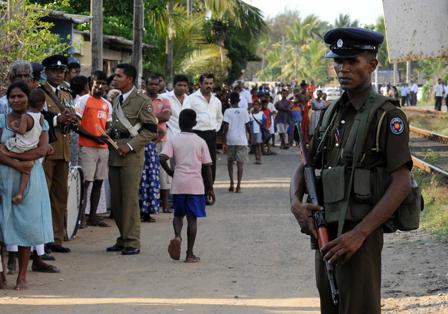
LAKRUWAN WANNIARACHCHI / AFP / picturedesk.com
The Missing
At one point Tamil Tiger suicide bombs were going off on an almost weekly basis - Paul Theroux describes an atrocity at a maternity clinic, the perpetrator disguising her bomb as an advanced pregnancy.
Seeing troops on the streets on Paris following November's terror attacks, I've been thinking about what, as a civilian society, we will accept as "normal"? Increased surveillance? The collatoral damage of drone strikes?
In Sri Lanka the new normal began to include "white van disappearances" - late-night knocks on the doors of suspected rebel sympathisers that have left tens of thousands of people - brothers, fathers, husbands, sisters and wives - missing.
It was a bitter conflict that had been initially sparked by ethnic violence led by marauding mobs in 1983. The killing of 13 Sinhalese government soldiers avenged by angry cudgel wielding civilians, a riot than began in the Colombo suburb of Borella and spread across the country until hundreds of Tamils had been killed and 18,000 of their properties had been destroyed. They called it Kalu Juliya or "Black July".
Truth and Reconciliation
It was in essence a war that pitted former neighbours against each other - the most traumatic of conflicts. And it is going to take a significant process healing for the country to recover from this trauma.
"It’s an incredibly challenging thing for a country to move on from such a violent and divided history," says Kate Cronin-Furman, a political scientist and human rights lawyer who has worked in northern Sri Lanka. It’s only 7 years since the end of the war and, as Cronin-Furman puts it: "For 5 of those years the regime that was responsible for those abuses remained in power. We wouldn’t expect a perfect rosy future with everyone holding hands and singing songs together. That said I think the pace of reconciliation and change has been disappointing for victims."
"We wouldn’t expect a perfect rosy future"
The world may be a better place without the Tamil Tigers, led by moustachioed Velupillai Prabhakaran, a stubborn, portly diabetic; an utterly ruthless man who personally assassinated moderate Tamil politicians, and, exasperatingly, repeatedly rejected compromise.
His forces forcibly conscripted of child soldiers, and shot any who tried to flee. The Tigers, whose funding began to dry up after 9/11, were listed as a terror group in the European Union and the USA. The government still describes its final months-long operation to finally eradicate their leadership and cadres, trapped on a narrow strip of sand between a lagoon and the sea near the northern city of an "anti-terror" operation.
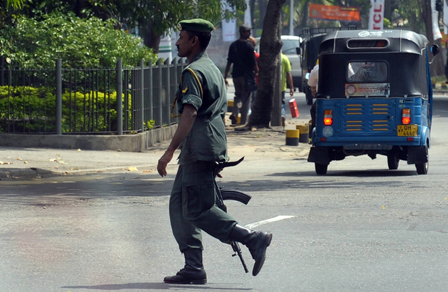
LAKRUWAN WANNIARACHCHI / AFP / picturedesk.com
On the 16th May 2009, speaking at a G11 summit in Jordan the Sri Lankan President Mahinda Rajapaksa announced victory. "My government has, in an unprecedented humanitarian operation, defeated the LTTE military. I’ll be going back to a country that has been totally freed from the barbaric acts of the LTTE."
Anything but humanitarian
But human rights groups say the operation was anything but humanitarian and the final denouement of the war still haunts the island.
It wasn’t just the fighters who were trapped on that strip of sand in the Vanni - tens of thousands of hungry, terrified Tamil civilians were trapped alongside them, and according to journalist Frances Harrison, the government forces made little or no effort to discern between legitimate targets and innocent families.
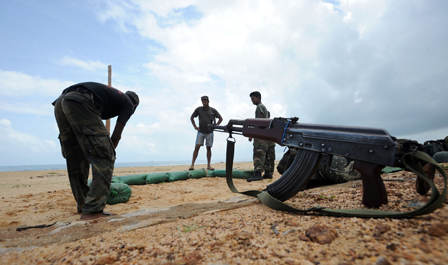
Ishara S. KODIKARA / AFP / picturedesk.com
"Civilians found themselves under shell attack, under Kfir supersonic jet fighter attack", recounts Harrison, author of the book Still Counting The Dead. "They found they were on the receiving end heavy artillery, of multi-barrelled rocket launchers which can fire up to 40 rockets in as many seconds… in areas that were not at all protected."
Human Rights Watch at the time described the Sri Lankan government’s artillery fire as "indiscriminate" and it seems the Tamil Tiger fighters were prepared to use Tamil civilians as human shields. Frances Harrison, whose book includes hundreds of interviews with survivors, says "The shelling hit civilians, hit food queues, hit hospitals, hit makeshift clinics, hit people queuing to get milk for their babies. There are hundreds of witnesses who talk about these attacks."
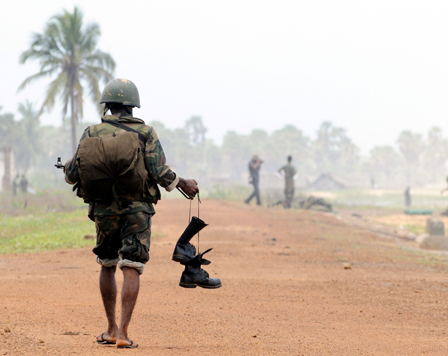
Ishara S. KODIKARA / AFP / picturedesk.com
Shocking Loss Of Civilian Life
The United Nations estimates that final government assault killed up to 40,000 civilians. But even that figure maybe too conservative, says journalist Frances Harrison:
"An internal report into the UN’s own role talked about up to 70,000 civilian deaths. We’re talking about a death toll that hasn’t even been established to the nearest ten thousand, which is shocking when you think about that scale of loss of life."
The War on Terror
The Sri Lankan government is extremely sensitive to Western criticism of the final acts of the war - which it still views in the prism of the global fight against terror. They have quite literally tried to bury the conflict in the sand, bulldozing the debris into the beach. But Pireeni Sundaralingam, a Sri Lankan Tamil who now lives in exile in San Francisco says this is dangerous. The neuroscientist and playwright says the trauma of 2009 must be properly processed:
"I think that when you think of war, there is always an official end date; in the sense of the cessation of physical hostilities. But as a psychologist I’m very concerned with the way in which there are consequences that carry on from conflicts, and I would argue for many, many years. Conflict doesn’t go away, it gets reborn in cycles."
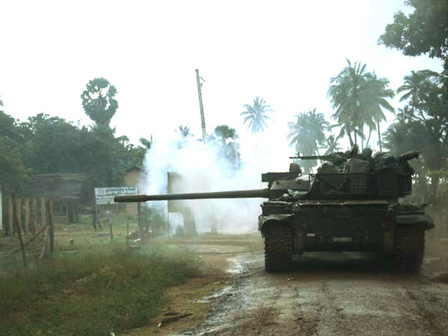
AFP / AFP / picturedesk.com
Talking About It
The only way to deal with trauma, in a psychological sense, is to talk about it - to honestly address the grievances left over from the conflict. But Pireeni Sundaralingam says we are a long way from that situation.
"The problem has not just been put aside. Unfortunately there are continuing to be atrocities. There are still detention centres and people continue to be disappeared."
Sundaralingam says Sri Lanka still lacks "a fully free" press and media in Sri Lanka. "That's fundamental for any civil society that one should have a free press so that even people inside the country can find out what is happening."
One of the worst concerns for human rights lawyer Kate Cronin-Furman are the people who are still missing. Some estimates put the number of those "unaccounted for" at 100,000.
"Their families have been devestated by this uncertaintly," she says. "They have spent at least these last seven years, at often over a decade, agitating for some information about their loved ones."
Even if they were told their loved ones had been killed that would bring some closure. They could mourn them properly and hold religious rites. "This is an extremely widespread and extremely traumatic fact of the post-war situation in Sri Lanka." She says the government's failure to provide any information about missing people has "kept the wounds of war" very fresh.
This also matters internationally. Tom Malinowski, the former Human Rights Watch’s advocacy director who now works for the State Department, has argued, in the Washington Post, that if the international community powers to turn a blind eye to what he sees as Sri Lankan excesses, other countries will feel free to ignore the rules of war in prosecuting wars on their own insurgencies.
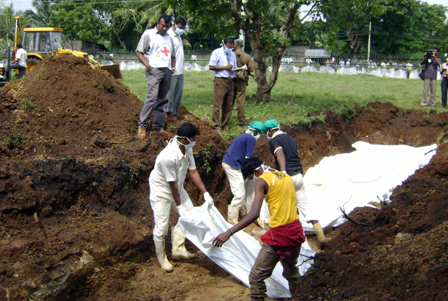
STR / AFP / picturedesk.com
There was hope that a change in government would bring in a change of attitude. The war time President Mahinda Rajapaksa was surprisingly toppled in an election in January 2015 by his former party colleague Maithripala Sirisena. He has been seen as slightly more open to addressing the past than his predecessor.
Pireeni Sundaralingam is calling on the new government to introduce a meaningful truth and reconciliation commission based on the model of post-Apartheid South Africa.
"The tendency has been to say in order to move forward into the future in a peaceful way we can’t acknowledge the problems that have happened in the past."
She says the government of Sri Lankans must address the grievances of those in the north or those seen as being on the losing side.
"There has been no attempt to hear their stories and how they have suffered. I think if you really genuinely want the population to come together after war and loss then something like the South African example is essential."



